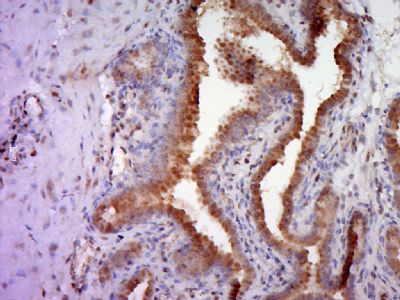The mammalian c-H-, c-K- and N-Ras proto-oncogenes encode ubiquitously expressed proteins (1,2). p21Ras can exist in either a physiologically quiescent GDP-binding state or a GTP-binding signal-emitting state (3). Oncogenic p21Ras proteins are trapped in the excited signal-emitting state because the mechanism normally employed to delimit their excitation period, hydrolysis of their bound GTP to GDP, is impaired as a result of specific mutations (3). Interaction of p21Ras with GTPase activating protein (GAP) can increase hydrolysis of p21Ras-bound GTP by as much as 1000-fold (4,5). The product of the neurofibromatosis type 1 gene (NF1) has also been shown to exhibit p21Ras GAP activity (6,7), and proteins that stimulate the GTPase activity of three other low molecular weight GTPases, including Rho, Rab 3A and Rap 1, have also been described (8,9).
Function:
Inhibitory regulator of the Ras-cyclic AMP pathway. Stimulates the GTPase of normal but not oncogenic Ras p21.
Subunit:
Interacts with SQSTM1. Interacts with SPSB1; the interaction does not promote degradation. Interacts with CAV2 (tyrosine phosphorylated form). Directly interacts with NCK1. Interacts with PDGFRB (tyrosine phosphorylated). Interacts (via SH2 domain) with the 'Tyr-9' phosphorylated form of PDPK1.
Subcellular Location:
Cytoplasm.
Tissue Specificity:
In placental villi, detected only in the trophoblast layer (cytotrophoblast and syncytiotrophoblast). Not detected in stromal, endothelial or Hofbauer cells (at protein level).
DISEASE:
Note=Mutations in the SH2 domain of RASA seem to be oncogenic and cause basal cell carcinomas.
Defects in RASA1 are the cause of capillary malformation-arteriovenous malformation (CMAVM) [MIM:608354]. CMAVM is a disorder characterized by atypical capillary malformations that are multiple, small, round to oval in shape and pinkish red in color. These capillary malformations are associated with either arteriovenous malformation, arteriovenous fistula, or Parkes Weber syndrome.
Defects in RASA1 are a cause of Parkes Weber syndrome (PKWS) [MIM:608355]. PKWS is a disorder characterized by a cutaneous flush with underlying multiple micro-arteriovenous fistulas, in association with soft tissue and skeletal hypertrophy of the affected limb.
Similarity:
Contains 1 C2 domain.
Contains 1 PH domain.
Contains 1 Ras-GAP domain.
Contains 2 SH2 domains.
Contains 1 SH3 domain.
SWISS:
P20936
Gene ID:
5921
Database links:
Entrez Gene: 5921 Human
Entrez Gene: 218397 Mouse
Entrez Gene: 25676 Rat
Omim: 139150 Human
SwissProt: P20936 Human
SwissProt: P50904 Rat
Unigene: 612880 Human
Unigene: 12223 Rat
| Picture |
Paraformaldehyde-fixed, paraffin embedded (Mouse placenta); Antigen retrieval by boiling in sodium citrate buffer (pH6.0) for 15min; Block endogenous peroxidase by 3% hydrogen peroxide for 20 minutes; Blocking buffer (normal goat serum) at 37°C for 30min; Antibody incubation with (p-RASA1) Polyclonal Antibody, Unconjugated (SL13281R) at 1:500 overnight at 4°C, followed by a conjugated secondary (sp-0023) for 20 minutes and DAB staining.
|
|
|
